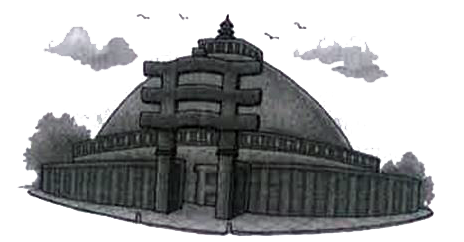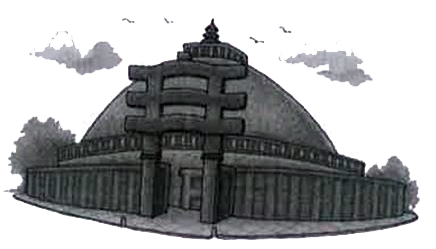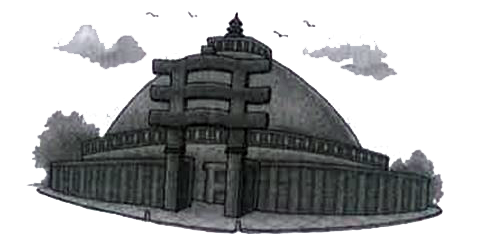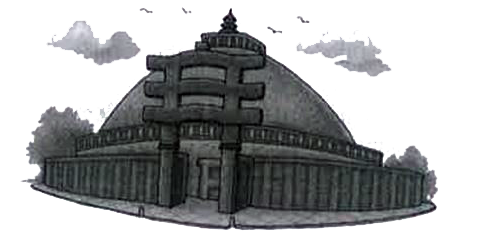Following is a narrative on Sanchi stupa. Listen to it carefully and answer the questions that follow. You can listen to the recorded narrative or ask your teacher, sibling or friend to read it aloud.
The fascinating and world famous Sanchi stupa is located on a hilltop in Sanchi town, Madhya Pradesh, India. It is one of the most important Buddhist monuments that portrays Buddhist art and sculpture. Starting from the third century BC through the twelfth century AD, it attracts the attention of thousands of visitors round the year including national and foreign tourists, archaeologists, and historians among others. This stupa is the oldest stone structure in India that was built during the Mauryan period. Originally commissioned in the third century BCE by Emperor Ashoka, this huge hemispherical dome consists of a central chamber. In this chamber, the relics of Lord Buddha are placed. The original construction work of this stupa was supervised by Ashoka. His wife, Devi, was the daughter of a merchant of nearby village. Vidisha. Sanchi was also her birthplace as well as the venue of her and Ashoka's wedding. Later, four omamental gateways or toranas facing four directions and a balustrade surrounding the stupa were added in the first century BCE. The Great stupa at Sanchi is one of the oldest stone structures in India and counted among the best conserved ancient stupas of Central India. It has been enlisted as an UNESCO World Heritage Site since 1989.
The sculptures on the ornamental gateways or toranas consist of decorative illustrations of events encompassing the life of Lord Buddha. These events are explained in the Jataka tales. The tree used here symbolises Lord Buddha. The most striking features regarding the stupa is that Lord Buddha has been depicted symbolically by figures like thrones, wheels, and footprints among others.
Who are the people who visit this Stupa throughout the year?

National and foreign tourists, archaeologists and historians visit the stupa throughout the year.
Topper's Solved these Questions
- THE SERMON AT BENARASBOOK - FULL MARKSCHAPTER - THE SERMON AT BENARASEXERCISE - SPEAKING Page-148
1 Videos
- THE SERMON AT BENARASBOOK - FULL MARKSCHAPTER - THE SERMON AT BENARASEXERCISE - WRITING
2 Videos
- THE SERMON AT BENARASBOOK - FULL MARKSCHAPTER - THE SERMON AT BENARASEXERCISE - EDITING Page -145
1 Videos
- THE PROPOSAL BOOK - FULL MARKSCHAPTER - THE PROPOSAL EXERCISE - PROJECT
1 Videos
- THE SERMON AT BENARESBOOK - FULL MARKSCHAPTER - THE SERMON AT BENARESEXERCISE - ADDITIONAL QUESTIONS SOLVED (LONG ANSWER TYPE QUESTIONS )
4 Videos
Similar Questions
Following is a narrative on Sanchi stupa. Listen to it carefully and answer the questions that follow. You can listen to the recorded narrative or ask your teacher, sibling or friend to read it aloud.
The fascinating and world famous Sanchi stupa is located on a hilltop in Sanchi town, Madhya Pradesh, India. It is one of the most important Buddhist monuments that portrays Buddhist art and sculpture. Starting from the third century BC through the twelfth century AD, it attracts the attention of thousands of visitors round the year including national and foreign tourists, archaeologists, and historians among others. This stupa is the oldest stone structure in India that was built during the Mauryan period. Originally commissioned in the third century BCE by Emperor Ashoka, this huge hemispherical dome consists of a central chamber. In this chamber, the relics of Lord Buddha are placed. The original construction work of this stupa was supervised by Ashoka. His wife, Devi, was the daughter of a merchant of nearby village. Vidisha. Sanchi was also her birthplace as well as the venue of her and Ashoka's wedding. Later, four omamental gateways or toranas facing four directions and a balustrade surrounding the stupa were added in the first century BCE. The Great stupa at Sanchi is one of the oldest stone structures in India and counted among the best conserved ancient stupas of Central India. It has been enlisted as an UNESCO World Heritage Site since 1989.
The sculptures on the ornamental gateways or toranas consist of decorative illustrations of events encompassing the life of Lord Buddha. These events are explained in the Jataka tales. The tree used here symbolises Lord Buddha. The most striking features regarding the stupa is that Lord Buddha has been depicted symbolically by figures like thrones, wheels, and footprints among others.
Which Buddhist monument is referred to here and what does it portray?

View SolutionFollowing is a narrative on Sanchi stupa. Listen to it carefully and answer the questions that follow. You can listen to the recorded narrative or ask your teacher, sibling or friend to read it aloud.
The fascinating and world famous Sanchi stupa is located on a hilltop in Sanchi town, Madhya Pradesh, India. It is one of the most important Buddhist monuments that portrays Buddhist art and sculpture. Starting from the third century BC through the twelfth century AD, it attracts the attention of thousands of visitors round the year including national and foreign tourists, archaeologists, and historians among others. This stupa is the oldest stone structure in India that was built during the Mauryan period. Originally commissioned in the third century BCE by Emperor Ashoka, this huge hemispherical dome consists of a central chamber. In this chamber, the relics of Lord Buddha are placed. The original construction work of this stupa was supervised by Ashoka. His wife, Devi, was the daughter of a merchant of nearby village. Vidisha. Sanchi was also her birthplace as well as the venue of her and Ashoka's wedding. Later, four omamental gateways or toranas facing four directions and a balustrade surrounding the stupa were added in the first century BCE. The Great stupa at Sanchi is one of the oldest stone structures in India and counted among the best conserved ancient stupas of Central India. It has been enlisted as an UNESCO World Heritage Site since 1989.
The sculptures on the ornamental gateways or toranas consist of decorative illustrations of events encompassing the life of Lord Buddha. These events are explained in the Jataka tales. The tree used here symbolises Lord Buddha. The most striking features regarding the stupa is that Lord Buddha has been depicted symbolically by figures like thrones, wheels, and footprints among others.
In which period the Stupa was built, and who commissioned it?

View Solution
Knowledge Check
Great Stupa at Sanchi is in
AUttar PradeshBMadhya PradeshCArunachal PradeshDAndhra PradeshGreat Stupa at Sanchi is in
AUttar PradeshBMadhya PradeshCArunachal PradeshDAndhra PradeshGreat Stupa at Sanchi is in
AUttar PradeshBMadhya PradeshCArunachal PradeshDAndhra Pradesh
Following is a narrative on Sanchi stupa. Listen to it carefully and answer the questions that follow. You can listen to the recorded narrative or ask your teacher, sibling or friend to read it aloud.
The fascinating and world famous Sanchi stupa is located on a hilltop in Sanchi town, Madhya Pradesh, India. It is one of the most important Buddhist monuments that portrays Buddhist art and sculpture. Starting from the third century BC through the twelfth century AD, it attracts the attention of thousands of visitors round the year including national and foreign tourists, archaeologists, and historians among others. This stupa is the oldest stone structure in India that was built during the Mauryan period. Originally commissioned in the third century BCE by Emperor Ashoka, this huge hemispherical dome consists of a central chamber. In this chamber, the relics of Lord Buddha are placed. The original construction work of this stupa was supervised by Ashoka. His wife, Devi, was the daughter of a merchant of nearby village. Vidisha. Sanchi was also her birthplace as well as the venue of her and Ashoka's wedding. Later, four omamental gateways or toranas facing four directions and a balustrade surrounding the stupa were added in the first century BCE. The Great stupa at Sanchi is one of the oldest stone structures in India and counted among the best conserved ancient stupas of Central India. It has been enlisted as an UNESCO World Heritage Site since 1989.
The sculptures on the ornamental gateways or toranas consist of decorative illustrations of events encompassing the life of Lord Buddha. These events are explained in the Jataka tales. The tree used here symbolises Lord Buddha. The most striking features regarding the stupa is that Lord Buddha has been depicted symbolically by figures like thrones, wheels, and footprints among others.
Where is the central chamber in the Stupa? What is kept inside it?

View SolutionFollowing is a narrative on Sanchi stupa. Listen to it carefully and answer the questions that follow. You can listen to the recorded narrative or ask your teacher, sibling or friend to read it aloud.
The fascinating and world famous Sanchi stupa is located on a hilltop in Sanchi town, Madhya Pradesh, India. It is one of the most important Buddhist monuments that portrays Buddhist art and sculpture. Starting from the third century BC through the twelfth century AD, it attracts the attention of thousands of visitors round the year including national and foreign tourists, archaeologists, and historians among others. This stupa is the oldest stone structure in India that was built during the Mauryan period. Originally commissioned in the third century BCE by Emperor Ashoka, this huge hemispherical dome consists of a central chamber. In this chamber, the relics of Lord Buddha are placed. The original construction work of this stupa was supervised by Ashoka. His wife, Devi, was the daughter of a merchant of nearby village. Vidisha. Sanchi was also her birthplace as well as the venue of her and Ashoka's wedding. Later, four omamental gateways or toranas facing four directions and a balustrade surrounding the stupa were added in the first century BCE. The Great stupa at Sanchi is one of the oldest stone structures in India and counted among the best conserved ancient stupas of Central India. It has been enlisted as an UNESCO World Heritage Site since 1989.
The sculptures on the ornamental gateways or toranas consist of decorative illustrations of events encompassing the life of Lord Buddha. These events are explained in the Jataka tales. The tree used here symbolises Lord Buddha. The most striking features regarding the stupa is that Lord Buddha has been depicted symbolically by figures like thrones, wheels, and footprints among others.
The toranas are decorated with: (Tick the right answer
(a) stone omaments
(b) events of Lord Buddha's life ( )
(c) Lord Buddha's relics ( )
(d)symbolic depiction of Lord Buddha as throne , wheel, footprints , etc. ( )

View SolutionFollowing is a narrative on Sanchi stupa. Listen to it carefully and answer the questions that follow. You can listen to the recorded narrative or ask your teacher, sibling or friend to read it aloud.
The fascinating and world famous Sanchi stupa is located on a hilltop in Sanchi town, Madhya Pradesh, India. It is one of the most important Buddhist monuments that portrays Buddhist art and sculpture. Starting from the third century BC through the twelfth century AD, it attracts the attention of thousands of visitors round the year including national and foreign tourists, archaeologists, and historians among others. This stupa is the oldest stone structure in India that was built during the Mauryan period. Originally commissioned in the third century BCE by Emperor Ashoka, this huge hemispherical dome consists of a central chamber. In this chamber, the relics of Lord Buddha are placed. The original construction work of this stupa was supervised by Ashoka. His wife, Devi, was the daughter of a merchant of nearby village. Vidisha. Sanchi was also her birthplace as well as the venue of her and Ashoka's wedding. Later, four omamental gateways or toranas facing four directions and a balustrade surrounding the stupa were added in the first century BCE. The Great stupa at Sanchi is one of the oldest stone structures in India and counted among the best conserved ancient stupas of Central India. It has been enlisted as an UNESCO World Heritage Site since 1989.
The sculptures on the ornamental gateways or toranas consist of decorative illustrations of events encompassing the life of Lord Buddha. These events are explained in the Jataka tales. The tree used here symbolises Lord Buddha. The most striking features regarding the stupa is that Lord Buddha has been depicted symbolically by figures like thrones, wheels, and footprints among others.
What structures were added to the huge hemisphere in first century BCE?

View SolutionStupas
View SolutionWhere is the highest in the world ‘Vishwa Shanti Stupa’ located in Bihar
View Solution
